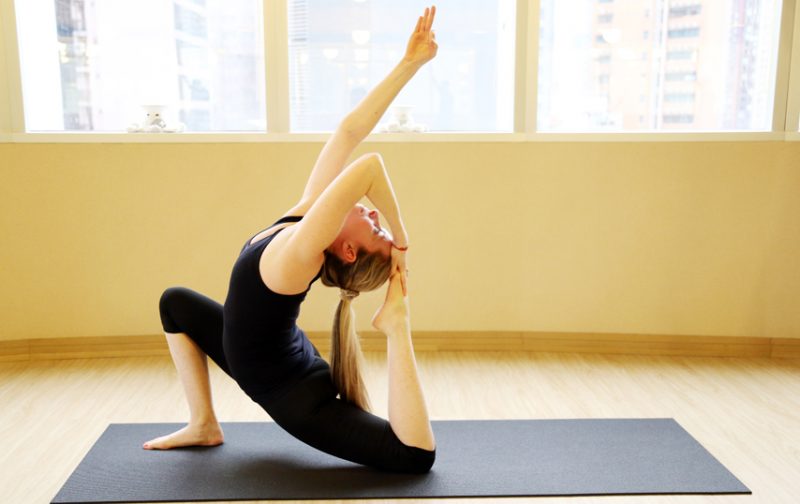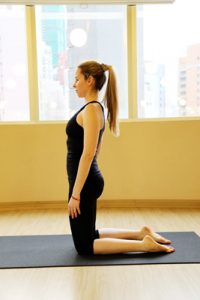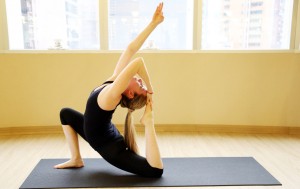This month’s featured pose is quite wordy – Eka Pada Nindra Raja Kapotasana. The term is derived from the following terms:
■ “eka” or one
■ “pada” or foot/leg
■ “nindra” or standing
■ “raja” or king
■ “kapota” or pigeon”, and
■ “asana” or pose
As with all backward bends, this pose creates a nice opening in the chest and strengthens the back and hip area. Since it has a lot to do with balance, this pose requires the practitioner to be fully into the practice and not distracted by external interruptions. A common misconception about backward bending poses is that is only deals with the back muscles – the truth it, the back can only arch and go deeper if it supported by the front body’s muscles.
Keep in mind that there will always be a counter-reaction for every movement. While the back is arched and becomes more flexible, the front side of the body also strengthens to hold up the body, ensuring that the body is well protected.
Chakra Awareness
Anahata Chakra / Heart
Practice Level
Advanced
Degree of Difficulty(100 being most difficult)
85
Movement
Backward Bending
A spinal movement done with the extension of the spine, supported by different back muscles.
Shoulder Girdle Elevation / Upward Rotation
A lateral and upward movement of the scapula or shoulder blades.
Challenges faced during the practice
Chest tightness and breathing difficultyBack limitationLightheadednessBalance
Chances of Injury
Back compression and neck strain
Contraindications
Existing back, neck or spinal injury
High or low blood pressure
As the top of the head goes bckwards, those with irregular blood pressure might feel lightheadedness or nausea while or after doing the pose.
Hyperkyphosis
Refers to an excessive curvature of the thoracic spine, commonly referred to as hunchback. As this is a backward bending pose, having a hunched back poses a difficulty in achieving the pose.
Major Muscles Involved
Rectus Abdominis
It is responsible for the flexing of the lumbar spine and keeping the internal organs intact, therefore working with the Erector Spinae especially in backward bending movements.
Pectoral
Composed of the Pectoralis Major and Pectoralis Minor, this muscle makes up most of the chest area muscles and is responsible for the movement of the shoulder joint. The Pectoralis Major keeps the arm attached to the trunk of the body while the Pectoralis Minor stabilizes the scapula.
Erector Spinae
A muscle group found in the back, which extends the vertebral column in Bouncy Castle forward and backward bending. This muscle is responsible for returning the vertebral column to the erect position after motion.
Deltoid
The muscle forming the rounded shape in the shoulders, the deltoid muscles assist and support in the abduction of the shoulder.
Trapezius
One of the major muscles of the back, the trapezius is responsible for moving, rotating, and stabilizing the shoulder blades and extending the head at the neck.
Quadriceps
A large muscle group that includes the four prevailing muscles on the front of the thigh, which act as extensors of the knee joint.
Best Time to Practice
Afternoon or evening, when the body’s natural flexibility is present
Warm-up
The below poses target different muscles in the body which are essential to coming into Eka Pada Nindra Kapotasana.
Banarasana / Lunge Quadriceps stretch variations
- Come into a lunge position, resting the left knee on the floor and right foot below the right knee.
- Bend the left leg, turn the torso facing left and rotate the shoulder externally. Hold the left foot from behind, with the elbow pointing back. Keep the gaze forward, then slowly bring the torso facing forward.
- Inhale and on exhale, bring the left heel closer to the left buttocks. Hold the pose for a few deep breaths.
Steps
Start in a kneeling position.
Final Pose
Slowly extend the right arm over the head, the index finger and thumb pressing lightly in cin mudra.
….more
To read the full article please download our Asana Journal App or purchase Issue 156 Dec 2015.























 Other
Other